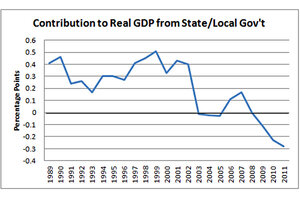Local budget cuts drag down the entire economy
Instead of raising taxes, cities and states are balancing their budgets by laying off teachers, cops, maintenance workers. The loss of state and local jobs slows fiscal growth for everyone.

This chart, compiled with Bureau of Economic Analysis data, shows the contribution of state and local governments to the US Real Gross Domestic Product since 1989. The percent that local and state governments contribute has dropped sharply in the past decade, to the point that they are now taking away from the Real GDP.
Jared Bernstein/BEA
Here’s one reason we’re stuck in slow growth mode: the budget crunch among state and local governments.
The figure shows the yearly percentage point contribution to or subtraction from real GDP growth from the state and local sectors since the late 1980s. The trend bounces around but the recent cliff dive is evident. It’s also why we keep losing jobs in these sectors month after month.
Unlike the feds, states have to balance their budgets every year, which means they either raise taxes or cut services. They haven’t done much on the tax side, so they’ve been laying off teachers, cops, maintenance workers; practically every month over the past few years we’ve been adding private sector jobs and shedding public sector jobs.
In a very real sense, what you have here is a microcosm of austerity measures at work in cities and towns across the country. Moreover, this drag on growth is avoidable. One of the most successful parts of the Recovery Act was state fiscal relief, as those dollars went directly to preserving state and local jobs. The American Jobs Act proposed $35 billion to build on that progress, resources that would have prevented hundreds of thousands of ongoing layoffs. But it languishes in the dysfunctional Congress and we’re left with the fiscal drag you see in the figure.
Update: A commenter notes that this figure is a good argument against a balanced budget amendment. Amen. As I wrote around the time of that debate–and this bad idea hasn’t gone away–think of a recession as all the states piled in a boat together along with the federal government and the boat is taking on water. There’s really only one institution in that boat with bilge pump and that’s the feds. A BBA takes the pump away…then the boat sinks…

